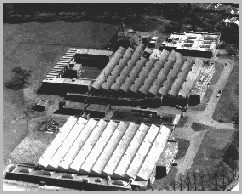
The "Tick-Tock"
The visitor in 1962
A report by T.R. Robinson F.B.H.I. in the "HOROLOGICAL JOURNAL" January 1963
Anyone who pictures all South Wales as one big stretch of grimy mining valleys, vast colliery sidings, and smoke-belching chimneys will find just how mistaken they are if they visit Ystradgynlais, for the whole surroundings of the Gurnos Works of the Anglo-Celtic Watch Co. have nothing grim or sordid about them, and, in fact rather resemble the Jura area of Switzerland.
Gurnos Works
from the air
 The factory
itself, which stands close beside the very similar Enfield Works
where Smiths Clocks are produced, was built on a stretch of former
parkland, and is in ideal surrounding, and as modern, clean,
and attractive as even a watch factory can be. Placed well back
from the road, the works is arranged with its executive and drawing
offices in front, the raw-material and finished part stores behind
them, and the machine shops behind them again, with the movement
assembly section housed in spacious two-storey halls - one can
hardly call them "shops" - that provide perfect conditions
for this work.
The factory
itself, which stands close beside the very similar Enfield Works
where Smiths Clocks are produced, was built on a stretch of former
parkland, and is in ideal surrounding, and as modern, clean,
and attractive as even a watch factory can be. Placed well back
from the road, the works is arranged with its executive and drawing
offices in front, the raw-material and finished part stores behind
them, and the machine shops behind them again, with the movement
assembly section housed in spacious two-storey halls - one can
hardly call them "shops" - that provide perfect conditions
for this work.